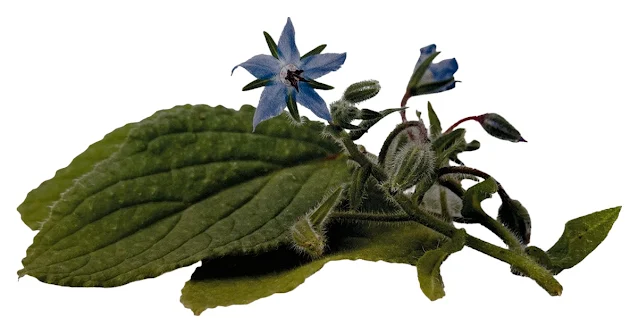Also known as starflower, borage is an annual herb that had its origins in the Mediterranean, around Aleppo. This kitchen garden regular has naturalized over the years and is now found growing wild in many areas of the world. Borage is also grown commercially for its valuable seed oil.
The borage plant reaches a height of two to three feet, with stems and leaves covered with white, prickly hair. The leaves alternate and are deep green, wrinkled, and oval. The star-shaped flowers, which form floral displays, are most often blue with distinctive black anthers-called the "beauty spot" by plant lovers. Pink flowers sometimes occur and there is a white variety. Many flowers bloom simultaneously, indicating that the plant has a high degree of intra-plant pollination. Borage spreads easily and in temperate zones will bloom from June to September. In milder climates, it may bloom all year.
In the Mediterranean, the name is spelled with two r's, so it is possible the name came from the Italian borra or the French bourra, meaning "hair" or "wool"-referring to the plant's hairy stems and leaves. Both words have their root in the Latin burra, which means "flock of wool."
Culinary Uses
Borage can be utilized either as a fresh vegetable it tastes of cucumber and is often used in salads or as a garnish-or as a dried herb. The flowers. which contain a nontoxic pyrrolizidine alkaloid called thesinine, have a delightful honey-like taste and are used to decorate desserts, making them one of the few truly blue foods.
Borage is used as a vegetable in the cuisine of Crete and in Germany in soups and green sauce. In the Spanish regions of Navarre and Aragon, it is boiled and served with garlic, and, in the north ern Italian region of Liguria, it is traditionally used as a filling for ravioli and pansotti.
Borage is also the traditional garnish for that lawn party favorite Pimm's Cup cocktail, although it is often replaced by a cucumber peel or a sprig of mint. It is one of the botanical flavorings in Gilpin's Westmoreland Extra Dry Gin, and it is still used in Poland to pickle gherkins.
Nutritional Value
Borage contains the minerals potassium and calcium. It also contains nitrate of potash.
Healing Properties
Herbalists have used borage to treat everything from colic, cramps, and diarrhea to asthma and bronchitis, to cardiovascular and urinary disor ders. Naturopathic healers use the herb for regulating hormones and metabolism, and for remedying symptoms of menopause, such as hot flashes.
In Iran, the plant is made into a tea for treating colds, flu, rheumatoid arthritis, and inflammation of the kidneys. The tea is also believed to bring more oxygen to the heart, which makes it a healthy choice for those suffering from heart conditions.
History and Lore
- The name borage may come from the Celtic term barrach, which means "man of courage."
- John Gerard, a 16th-century botanist, says that Roman naturalist Pliny called the herb Euphrosinum because it "maketh a man merry and joyfull." Pliny also claimed that borage was the "nepenthe" mentioned in Homer's Odyssey, which brought about total forgetfulness.
- In the early 17th century, English philosopher and scientist Francis Bacon wrote that borage "hath an excellent spirit to repress the fuligi nous vapour of dusky melancholie."
- Nicholas Culpeper, a noted 17th-century English botanist, commented that the herb was beneficial for treating putrid fevers, venomous snakebite, jaundice, consumption, sore throat, and rheumatism.

